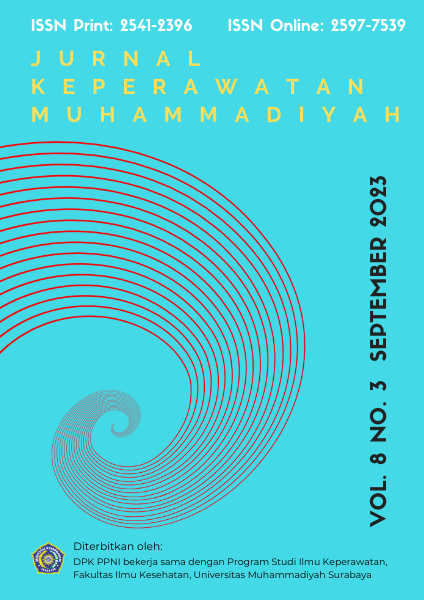Penerapan Slow Breathing Pada Asuhan Keperawatan Pasien Hipertensi Dengan Masalah Keperawatan Resiko Perfusi Serebral Tidak Efektif Di Ruang Penyakit Dalam RSUD Blambangan
DOI:
https://doi.org/10.30651/jkm.v8i3.20303Abstract
Objective: Hypertension is referred to as the silent killer because the symptoms in each individual vary and often do not show any symptom. Symptoms often complained of by people with hypertension are dizziness, weakness, fatigue, shortness of breath, anxiety, nuesea, vomiting, epitaxis, decreased conciousesness, and headaches which cause the narrowing of blood vassels so that blood circulation to the brain decreases. Patients with hypertension risk experiencing ineffective cerebral perfusion due to increased intracranial in the brain caused by atherosclerosis, so blood circulation becomes vulnerable, and problem with ineffective cerebral perfusion arise. Efforts to be made to relive neck pain in hypertensive patients are given slow braething relaxation therapy.
Methods: This study aimed to implement the application of slow breathing in nursing care of hypertension patients with ineffective cerebral perfusion risk nursing problems in the internal disease room of blambangan hospital.
Results: This paper used the case study method with the criteria of hypertensive clients who experience pain in the back of the head with ineffective cerebral perfusion risk nursing problem. Data was collected through interviews, obeservation, physical examination, and dokumentation using tge format of medicak surgical nursing care. The implementation of slow breathing was twice a day for 10 menutes.
Conclusion: The results of the study with cas a study approach showed that after being given the application of slow breathing, it was found that the pain felt in the back of the head of the client 1 was reduced from a scale of 5 to 1. The application of slow breathing was effective for reducing neck pain in hypertensive clients with cerebral perfusion risk nursing problema was not effective.
Downloads
Published
Versions
- 2024-01-04 (2)
- 2023-09-25 (1)
Issue
Section
License
Copyright (c) 2023 Alfi Duwi Agustina, Novita Surya Putri, Tria Anisa Firmanti, Atik Pramesti W

This work is licensed under a Creative Commons Attribution-ShareAlike 4.0 International License.
- Penulis tetap memegang hak atas karyanya dan memberikan hak publikasi pertama kepada jurnal ini yang secara simultan karya tersebut dilisensikan di bawah:Â Creative Commons Attribution-ShareAlike 4.0 International (CC BY-SA 4.0)













